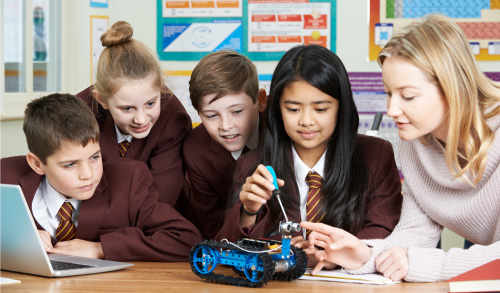In recent years, the integration of robotics in education has sparked a profound transformation in the way students engage with STEAM (Science, Technology, Engineering, Arts, and Mathematics) subjects. This shift from STEM to STEAM emphasises the importance of combining artistic and visual elements with traditional scientific and technological principles. Robotics, as a medium, has become a powerful tool to inspire and cultivate a diverse range of talents, connecting design with engineering and providing students with a holistic approach to problem-solving.
- The Fusion of Art and Science: The integration of robotics has led to a substantial shift from STEM to STEAM education. Recognising the significance of design alongside engineering, robotics innovations now actively incorporate visual and artistic elements. This approach not only enriches students' knowledge but also prepares them for future careers by nurturing creativity, critical thinking, and imaginative skills.
- Skills Beyond Knowledge: Robotics education goes beyond imparting knowledge in STEAM fields. It places a strong emphasis on cultivating essential life skills such as teamwork and communication. Through robotic projects, competitions, and collaborative activities, students are encouraged to work together, fostering an environment that demands problem-solving, effective communication, and the ability to verbalise thoughts clearly. Attention to detail becomes paramount in the world of robotics, teaching students the importance of precision and error-free execution.
- Empowering Minds and Building Confidence: Engaging in robotic activities stimulates and trains the mind to face challenges head-on. The mechanics of questioning, reasoning, reflecting, and imagining are integral to driving creativity in robotics. As students grapple with intricate sequences and logical skills, they not only enhance their problem-solving abilities but also boost their self-confidence and leadership skills. The confidence gained in successfully navigating through complex robotic tasks can be transformative, shaping students into resilient and capable individuals.
- Education Meets Robotics: The marriage of education and robotics at school offers students a myriad of advantages, particularly in preparing them for the competitive labour market. By providing hands-on experience and practical application of knowledge, students develop problem-solving techniques that involve breaking down complex problems into manageable fragments. This process not only enhances their understanding of theoretical concepts but equips them with the skills needed to devise effective solutions in real-world scenarios.
- Inclusivity in Learning: One of the remarkable aspects of robotics in education is its inclusivity. Robotics provides a versatile platform that caters to students of all levels and abilities. An illustrative example of this inclusivity is the development of robots designed to accommodate diverse learning styles, ensuring that every student has the opportunity to grasp and apply essential concepts.
- Training Robots, Training Students: The symbiotic relationship between training robots and training students is evident. As students engage in building, programming, and operating robots, they are simultaneously honing their own skills. This reciprocal process ensures that students are not merely passive recipients of information but active participants in their educational journey, acquiring valuable skills that extend beyond the realm of robotics.
In conclusion, the integration of robotics into education has ushered in a new era of STEAM learning, where the fusion of art and science, coupled with the development of essential skills, empowers students for future success. Robotics is not just about building machines; it's about building minds, fostering creativity, and preparing a generation of innovators and problem-solvers ready to face the challenges of the ever-evolving world.
